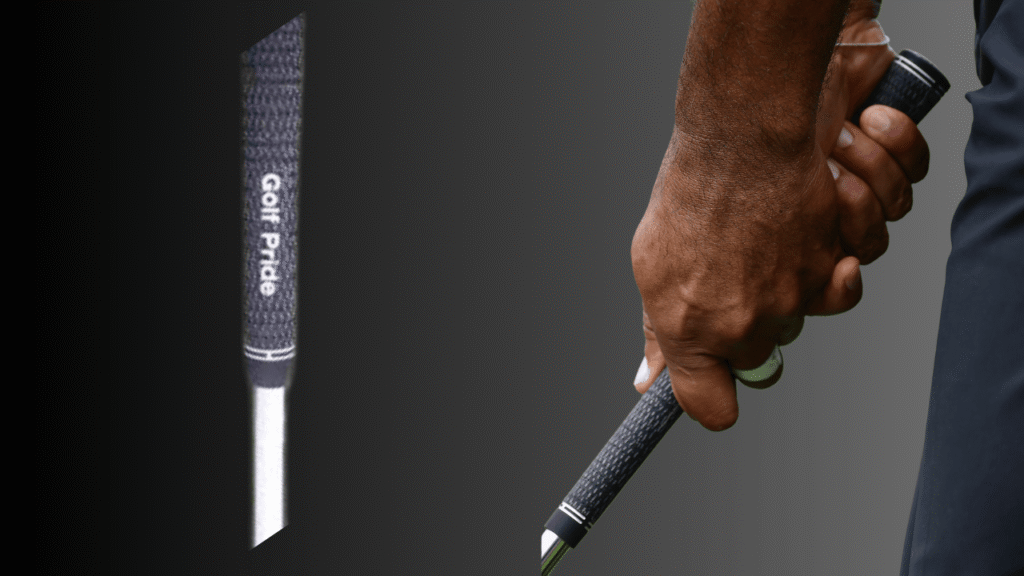If you’ve ever wondered how to choose the CORRECT GOLF grip size, you’re definitely not alone — and the truth is, this one detail could be quietly sabotaging your game. The right grip size isn’t just a comfort choice; it’s a total game-changer. It can sharpen your clubface control, boost your clubhead speed, and even reduce or eliminate that frustrating slice. In this comprehensive guide, we’ll walk you through everything you need to know to find the perfect grip size tailored to your hands and swing style. Because sometimes, the smallest tweak makes the biggest difference in your scorecard.
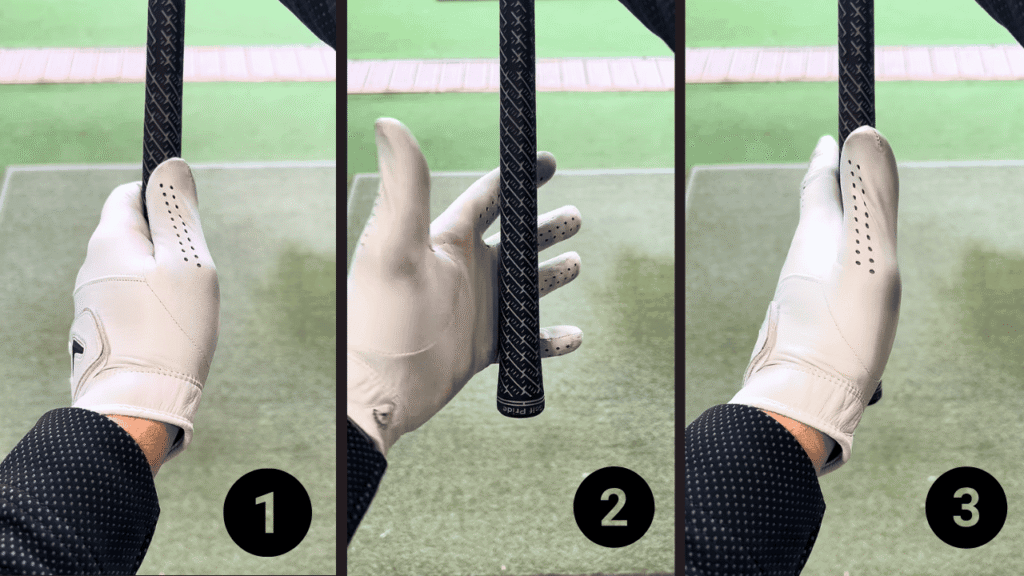
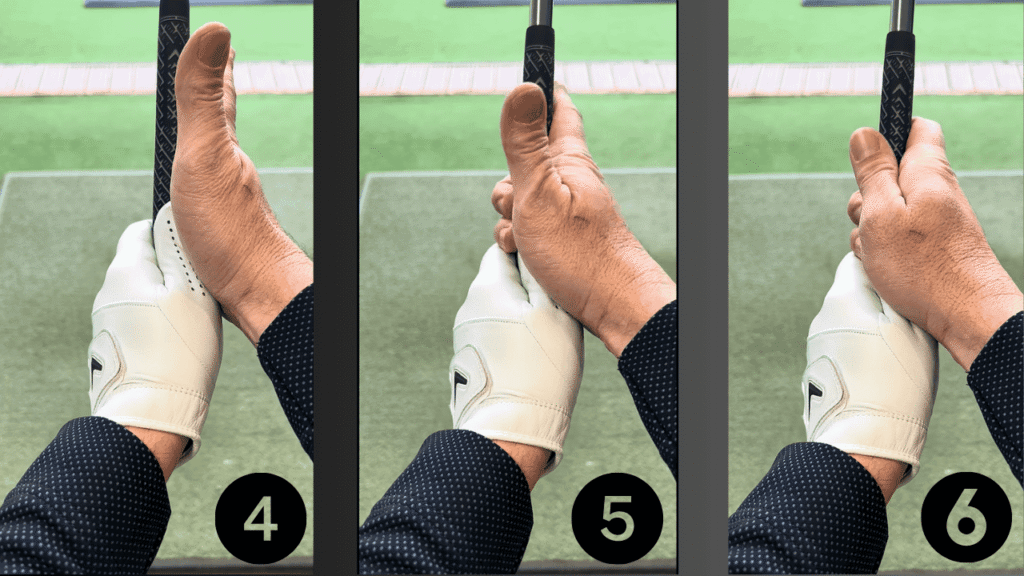
Why the Correct Grip Size Matters
The grip is your only physical connection to the golf club, so its size and feel are critical. Using a grip that’s too thin or too thick can negatively affect your swing mechanics, control, and power. The right grip size allows for the perfect balance between comfort and functionality, enabling you to square the clubface consistently and generate maximum clubhead speed.
Many golfers don’t realize how much grip size influences their swing. If your grip is too small, you might experience excessive wrist action, making your swing “handsy” and causing unwanted clubface rotation. Conversely, if your grip is too large, your hands may become less active, leading to an open clubface at impact and reduced clubhead speed.
Impact of a Grip That Is Too Thin
When your grip is too thin for your fingers and hands, it forces your wrists to compensate during the swing. This increased wrist action can lead to excess rotation, making it harder to control the clubface and resulting in inconsistent shots. You might also notice discomfort or pressure marks on your hands, signaling that your grip is not the right size.
Impact of a Grip That Is Too Thick
On the flip side, a grip that is too thick reduces the involvement of your hands and wrists in the swing. This can cause the clubface to stay open more frequently, decreasing your chances of hitting straight shots. Additionally, a thicker grip often reduces clubhead speed, limiting your distance potential. While some professional golfers like Bryson DeChambeau use extra-thick grips to encourage more body rotation, this approach is not suitable for most club golfers.
Guide to Golf Grip Materials
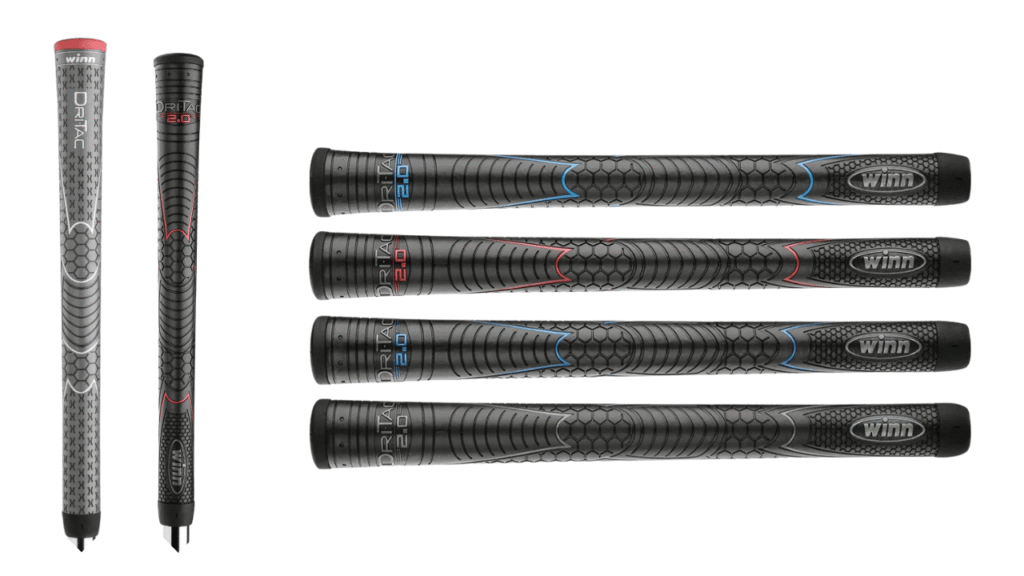
1. Rubber Grips: The Go-To Classic
Rubber grips are the most widely used option among golfers of all skill levels, thanks to their versatility and comfort.
✅ Pros:
- Soft and tacky feel for solid control
- Good shock absorption on impact
- Great for all-weather play (except heavy rain)
- Widely available in many styles
❌ Cons:
- Can wear out with heavy use
- May lose grip in hot, sweaty, or wet conditions
Best For:
Casual golfers, beginners, or anyone looking for a solid all-around grip.
Popular Rubber Grips:
- Golf Pride Tour Velvet
- SuperStroke S-Tech Rubber
- Lamkin Crossline
2. Cord Grips: Built for Control and Weather Resistance
Cord grips are made by embedding strands of cotton cord into rubber, creating a textured surface that bites into your hands — rain or shine.
✅ Pros:
- Excellent traction in wet, humid, or sweaty conditions
- Maximum feedback and feel
- Very durable — long-lasting performance
❌ Cons:
- Can feel rough or abrasive on the hands
- More expensive than basic rubber
- May be uncomfortable in cold weather
Best For:
Serious players, high-swing-speed golfers, and those who play in variable or wet weather.
Popular Cord Grips:
- Golf Pride Tour Velvet Full Cord
- Golf Pride MCC (Multi-Compound Cord)
- Lamkin UTx Solid Cord
3. Synthetic Grips: Comfort Meets Innovation
Synthetic grips use advanced materials like polymer blends or engineered rubber to create a soft, responsive feel with added durability.
✅ Pros:
- Lightweight and shock-absorbing
- Good moisture resistance
- Ideal for players with arthritis or joint pain
- Wide variety of textures and firmness levels
❌ Cons:
- Can be pricier than standard rubber
- Can wear down more quickly in very hot or cold conditions.
Best For:
Golfers looking for extra comfort, or those with hand fatigue or injuries.
Popular Synthetic Grips:
- Winn Dri-Tac
- SuperStroke Cross Comfort
- Lamkin ST+2 Hybrid
4. Leather Grips: The Vintage Vibe
Leather grips offer a traditional, premium feel. They’re often used by players who appreciate that classic, tour-inspired touch.
✅ Pros:
- Timeless look and feel
- Molds slightly to your hand over time
- Smooth and responsive
❌ Cons:
- Requires regular care and maintenance
- Less effective in wet conditions
- More expensive, and less common today
Best For:
Traditionalists or players who want luxury and feel above all else.
5. Hybrid Grips: The Best of Both Worlds
Hybrid grips combine two or more materials — usually rubber and cord — to offer the perfect blend of comfort and control.
✅ Pros:
- Dual textures for performance and feel
- Good all-weather traction
- Popular among competitive players
❌ Cons:
- Can be more expensive
- Not always customizable
Best For:
Golfers who want both comfort in the lower hand and control in the upper hand.
Popular Hybrid Grips:
- Golf Pride MCC
- Lamkin Sonar+ Hybrid
- SuperStroke S-Tech Cord
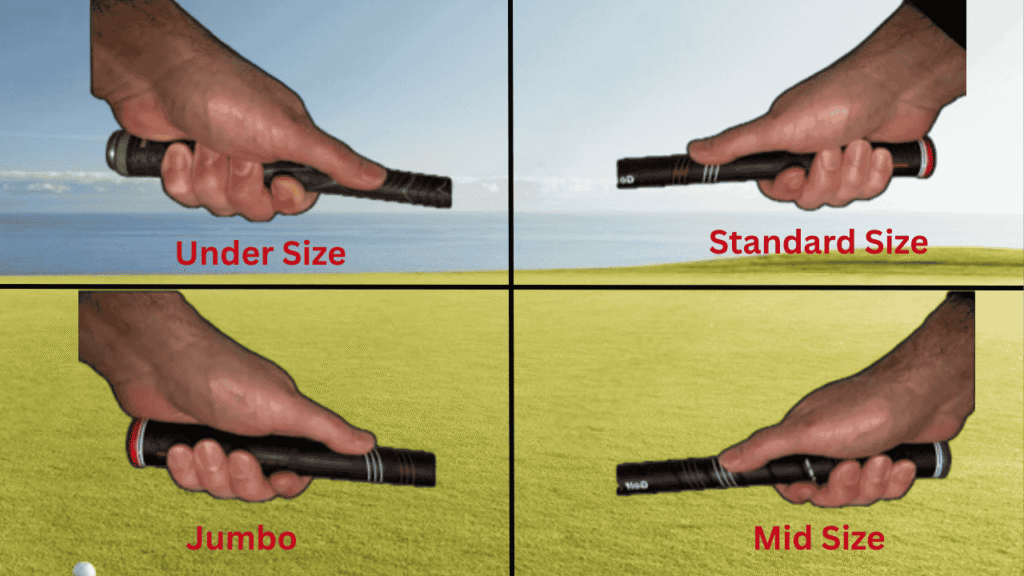
How to Determine Your Correct Grip Size
Finding the right golf grip size is all about balance and feel — where your fingers wrap around the grip comfortably, without pressing too deep or floating awkwardly.
Step 1: Know Your Glove Size
Your glove size is a solid starting point.
- If you wear a small or cadet glove, you might be suited to undersize or standard grips.
- If you wear a large or XL glove, you may benefit from midsize or jumbo grips.
But don’t stop there — glove size is helpful, not definitive.
Step 2: Measure Your Hand
To fine-tune your grip choice, measure the distance from the tip of your middle finger to the crease at the base of your palm, right where it meets your wrist. Use this chart as a reference:
Hand Measurement | Recommended Grip Size |
Under 6.5″ | Undersize |
6.5″ – 7.5″ | Standard |
7.5″ – 9″ | Midsize |
Over 9″ | Jumbo / Oversize |
Even a small shift in grip diameter can change how the club sits in your hands, affecting swing path, wrist action, and ball flight. Measure once — swing better forever.
Step 3: Check the Finger-to-Palm Gap
Grab the club like you’re ready to take a shot and observe how your fingers sit:
- Too Thin: If your fingertips press deep into your palm, the grip’s too small.
- Too Thick: If there’s a visible space between your fingertips and palm, the grip’s too big.
- Just Right: Your fingertips should just lightly touch your palm — no digging, no floating.
This is the “golden zone” — where control, comfort, and feel come together.
Pro tip: Many golfers find that a midsize grip with one extra wrap of tape gets them right into that comfort zone.
Step 4: Factor In Physical Needs
If you experience joint pain, arthritis, or hand fatigue, make sure not to overlook comfort. Grips with added cushioning — like Golf Pride’s CP2 Pro or similar soft-composite styles — can ease stress on your fingers and reduce tension during the swing.
✅ Benefits of cushioned grips:
- Less pressure = smoother tempo
- Better comfort = longer rounds
- Less pain = more consistency
That said, don’t overdo it — an oversized grip that’s too thick can slow wrist action and cost you clubface control.

How to Regrip Your Clubs
Regripping your clubs is a simple way to refresh your equipment and improve your game without buying new clubs. Over time, grips wear down, becoming slick and less effective. Installing new grips in the correct size can rejuvenate your clubs, making them feel almost brand new.
Many brands offer a variety of options, including multi-compound grips that combine softness and tackiness. Some golfers enjoy customizing their grips by color-coding their wedges, irons, and woods for a personalized look and feel. For example, pink wedges, red irons, and green woods not only add personality but can also help you visually differentiate your clubs quickly.
Final Tips for Maximizing Your Golf Game with the Correct Grip
- Regularly Check Your Grips: Grips wear out and can change in size over time. Make it a habit to inspect them before rounds or lessons.
- Don’t Be Afraid to Experiment: If you feel your swing is too “handsy” or lacks speed, try adjusting grip size before changing your swing mechanics.
- Consult a Professional: Getting fitted by a golf pro or club fitter can help you find the perfect grip size tailored to your hands and swing.
- Customize for Comfort: Use cushioned grips or gloves if you have aches, pains, or arthritis to maintain a relaxed grip pressure.
- Adapt for Different Clubs: Consider slight grip size variations between your driver and irons if you want to fine-tune your performance.
Conclusion
Selecting the right grip size is one of the easiest yet most effective upgrades you can make to improve your golf game. It directly influences your ability to control the clubface, generate speed, and hit straighter shots. Whether you’re a beginner or a seasoned player, taking the time to assess and adjust your grip size can lead to noticeable improvements in your swing and lower scores.
Keep in mind, the aim is to achieve a balanced grip where your fingertips lightly meet your palm—no extra pressure, no empty space. This ensures comfort, control, and power in every swing. Don’t overlook this small but mighty detail—your golf game will thank you.


